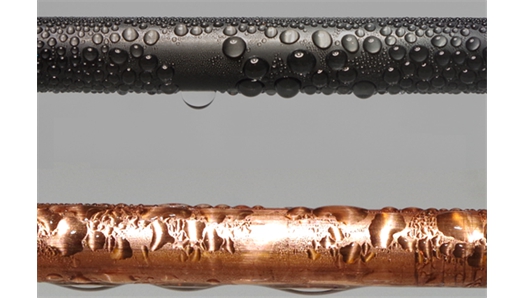 |
| September 12, 2023 | Volume 19 Issue 34 |
Designfax weekly eMagazine
Archives
Partners
Manufacturing Center
Product Spotlight
Modern Applications News
Metalworking Ideas For
Today's Job Shops
Tooling and Production
Strategies for large
metalworking plants
Steam condenser coating boosts power efficiency
If coal and natural gas power generation were 2% more efficient, then, every year, there could be 460 million fewer tons of carbon dioxide released and 2 trillion fewer gallons of water used. A recent innovation to the steam cycle used in fossil fuel power generation could achieve this.
Researchers at the University of Illinois Urbana-Champaign (UIUC) have developed a coating for steam condensers used in fossil fuel steam-cycle generation that is made with fluorinated diamond-like carbon, or F-DLC. The researchers reported in the journal Nature Communications that this coating could boost the overall process efficiency by 2%. In addition, they demonstrated the coating's suitability for industrial use by performing the longest durability test ever reported.

Copper steam condenser pipes coated with F-DLC (top) and without a coating (bottom). The F-DLC coating allows the condensed water to form into droplets rather than a thin film covering the pipe. [Credit: University of Illinois Urbana-Champaign]
"The reality is that fossil fuels aren't going away for at least 100 years," said Nenad Miljkovic, a professor of mechanical science and engineering at UIUC and the project lead. "A lot of CO2 is going to be emitted before we get to a place where we can lean on renewables. If our F-DLC coating were adopted globally, it would noticeably curtail carbon emissions and water usage for the existing power infrastructure."
Fossil fuel power generation depends on a process called the steam cycle, in which fuel is burned to boil water, the resulting steam spins a turbine, and the turbine drives an electric generator. The steam then reaches a condenser that both reclaims water from the steam and maintains a pressure difference across the turbine so the steam flows. Improving the condensers' heat transfer properties would allow a pressure difference to be maintained while burning less fuel.
The researchers' new F-DLC coating improves heat transfer because the material is hydrophobic. When the steam condenses into water, it does not form a thin film that coats the surface, like water does on many clean metals and their oxides. Instead, the water forms droplets on the F-DLC surface, putting the steam into direct contact with the condenser and allowing heat to be directly transferred. The researchers found that this improved the heat transfer properties by a factor of 20, which translates to a 2% overall process boost.
"It's remarkable that we can achieve this with F-DLC, something that just uses carbon, fluorene, and a little bit of silicon," said Muhammad Hoque, a postdoctoral research associate and the study's lead author. "It can coat pretty much any common metal, including copper, bronze, aluminum, and titanium."
To demonstrate F-DLC's durability, the researchers subjected coated metals to steam condenser conditions for 1,095 days, the longest test reported in the literature. The coated metals maintained their hydrophobic properties for this entire length of time. The researchers also found that the coated metals maintained their hydrophobic properties after 5,000 scratches in an abrasion test.
The research team is now collaborating with UIUC's Abbott Power Plant to study the coating's performance for six months of steady condensation exposure under industrial conditions.
"If all goes well, we hope to show everyone that this is an effective solution that is economically viable," Miljkovic said. "We want our solution to be adopted, because, although the development of renewable energy should absolutely be a priority, it's still very worthwhile to continue improving what we have now."
Read the researchers' article, "Ultra-resilient multi-layer fluorinated diamond-like carbon hydrophobic surfaces."
F-DLC-coated metals were provided by Oerlikon Balzers Coating. Researchers from Sabanci University also contributed to this study.
Source: University of Illinois Urbana-Champaign
Published September 2023
Rate this article
View our terms of use and privacy policy
